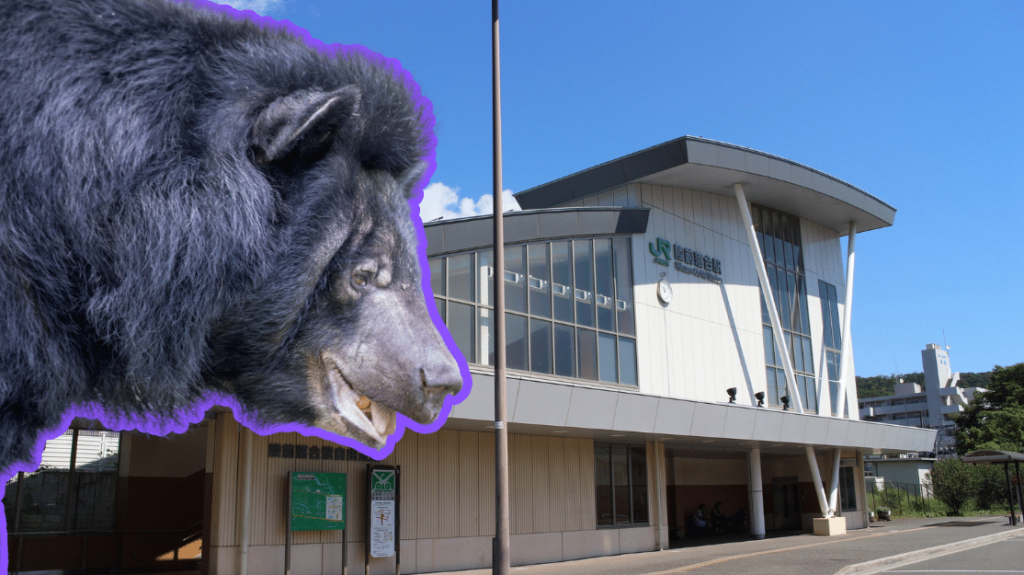[ad_1]
Japan faces a variety of challenges as its population ages and dwindles. From companies being short-staffed, to deliveries being more difficult, to the boom of need for home care nurses, to the difficulty in keeping pests like monkeys and boars out of agricultural fields efficiently, there’s a great deal.
We at Unseen Japan have covered some of the efforts to address these challenges by way of technology. But technology can only go so far in addressing these challenges. Especially when those challenges involve…bears.
In a new development, bears are moving into depopulated municipalities, especially in the northern Tohoku region. Read on to learn more about one bear’s interception in front of a Sendai train station, recent developments in Miyagi Prefecture’s bear problem, and how a livable solution for both humans and bears remains thus far elusive.
Bearing the Facts
The bears in question are Asian black bears. Known by their scientific name as ursus thibetanus, they’re also sometimes called moon bears. Consisting of several subspecies, their habitat ranges across a broad swath of Asia, from Iran in the west to Japan in the east.
They’re a familiar sight in historic Japanese art and folklore. Sakata no Kintoki, a mythical 10th-11th century folk hero famous for having been one of Minamoto no Yorimitsu’s loyal followers, is said to have fought and subdued one. In Edo period art, he is sometimes depicted together with a black bear.

However, despite this history in Japan, as of 2020, black bears are on the IUCN Red List of Threatened Species under the vulnerable category, one step before endangered. Emboldened by the dwindling human population in Japan, the bears are ranging further into urban areas.
But it isn’t just depopulation that’s driving this trend. The resultant desolation also plays a role.
Enter satoyama 里山, undeveloped woodlands near a populated area. These were buffer zones between bears and humans, but things have changed owing to the declining human population. Because there are more unoccupied lands, wild vegetation is reasserting itself, and the bears are ranging further until they enter urban areas like those on Sendai’s west side.
This leads us to Rikuzen-Ochiai Station, and the incident involving one inquisitive bear, which was a symptom of a much larger issue.
“So a Bear Walks into a Train Station…”
Rikuzen-Ochiai Station is a small JR East station on the Senzan Line. It lies just south of the Hirose River in Sendai’s western Aoba Ward. The Senzan train line connects Sendai with Yamagata City. It runs through the Ōu Mountains which divide the Tohoku region’s two coasts.
The station is in the part of Sendai’s Aoba Ward that extends into the forested mountains that run to the border of both Sendai City and Miyagi Prefecture. And one evening in September 2022, locals sighted a bear in front of the station, climbing a tree.

The bear, a female, was 1 meter 20 cm in length, and estimated at about 3 years old. A specialist contracted by the city for the job captured the animal before they put her down. Meanwhile, a short distance away in the Maebori area of Kami-Ayashi, a woman spotted three different bears. One of the trio was about 80 centimeters long.
No human casualties were reported in these September incidents. However, an earlier incident in August elsewhere in Aoba Ward saw an elementary student and his grandfather attacked by a different bear. As such, this has factored into the city and prefectural government’s growing concern over these incidents.
Indeed, bear attacks are only on the rise. In total, beyond just Sendai, Miyagi Prefecture reports five bear attacks between April and September of 2022, with seven people injured. This comes amidst an uptick in bear attacks in Japan overall of 2.3 percent since 2016.
Clearly, something must change.
In Lieu of Conclusion
Culling by hunting is one way that Japan controls the bear population nationwide, and Miyagi is no exception. However, in an effort to control the bear population, Miyagi Prefecture has raised the hunting limit to 15 percent of the animals’ total population, 3 percentage points above the Environment Ministry’s guidelines.
Despite increased culling being greenlit, city officials have stated that they’d rather coexist with the bears than kill them. And with the human population continuing to dwindle, and bears continuing to range into human cities, a long-term solution to the coming of the bears, in Sendai and elsewhere, remains elusive.
Sources
[ad_2]
Source link


